native plants
Planting as we go
Too many properties are landscaped as an afterthought, with plants going in long after all the other work is done (or not at all). This is not how we’re tackling Lewisham Farm.
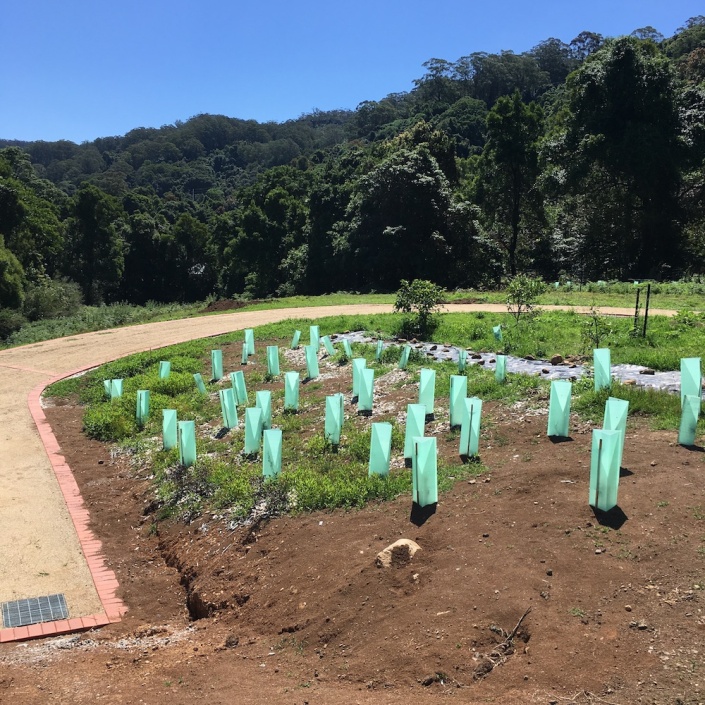
We’re intentionally planting as we go, entirely with Australian natives. This includes a wide mix of callistemons (‘bottle brushes’), grevillias, banksias and leptospermums (‘tea trees’).
There are good reasons for these plantings:
- Most flower heavily, attracting native birds and feeding the bees.
- They will flower throughout the year, providing Priscilla with cut flowers.
- They will screen things like the shed and water tanks, blending them into the landscape when viewed from the house or road.
- They help to define ‘garden rooms’, breaking up the acres into smaller spaces with their own character.
- When planted densely, they will keep down the weeds, at least to some degree.
- They will be beautiful, making the farm a lovely place to spend time.
By planting them early, they get a head start in the disturbed soil, before the grass and weeds have had a chance to reestablish themselves. It also means that we’ll get the benefits sooner!

By largely using tube stock plants, the cost of plants for a given area is only $50-100, which is nothing in the scheme of things.
And there’s much more planting to come…
Making progress with our railway plantings

The key to guerrilla gardening is to be indifferent to the survival of any one plant, while remaining passionate about the success of the garden as a whole.
In the year since I last blogged about our guerrilla gardening along the railway line, there has been plenty of progress, and a fair share of setbacks.
First the challenges:
- The railways folks decided to replace the electricity substation right next to the garden, leading to trucks being squeezed down the pedestrian pathway, crushing a pile of plants. (Their reworking of the security fence also killed off a bunch more.)
- Pretty much all of the groundcovers were wiped out by the big hailstorm.
- Local kids keep stealing the stakes used to hold the plant guards.
- Plants are randomly damaged, by dogs or passing people.
- Some plants simply don’t survive the harsh conditions.
But the good news:
- The garden has been progressively extended, and it’s now 10+ metres in length.
- The more established plants are now growing strongly, including all the acacias and callistomons.
- I’ve grown most of the plants from cuttings, so the cost has been minimal.
- Surprisingly few plants have been stolen.
The key is to keep planting each weekend, to replace the 2-3 plants that are damaged, and to then get slightly ahead. Over a year, this makes a big difference, and the pace should progressively increase.

I’ve had plenty of great comments from the locals, and it’s an enjoyable challenge. While it’s still early days, I think I’ve proved that one person can have an impact.
What can you do in your local area? 🙂
Starting a new strip of guerrilla gardening alongside the railway line

About six months ago I started planting natives beside Lewisham train station, taking the initiative where the council and railways hadn’t. That patch is growing well, although it’s constantly under threat from work vehicles which tend to drive down the pedestrian path.
So to diversify my risks, I’ve started guerrilla gardening the other end of the pedestrian way, where it meets West St. As can be seen from the photo above, it was hardly a delight for those walking by.

The starting point was to mattock over all the ground, breaking it up, and pulling out the grass and weeds. A full barrow-load of my best compost then went it to add some life back into the soil, along with a few handfuls of native-friendly fertiliser.

Marrickville Council nursery kindly maintains a pile of mulch, for free use by locals. Now that I have a ute, I took full advantage 🙂 What wasn’t used on the new strip went to supplement the existing plantings.
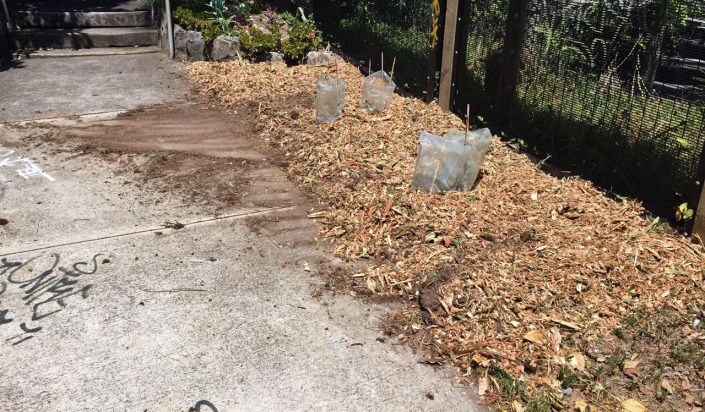
The result is a new strip of guerrilla gardening ready to be planted. It’s also a great way to get some exercise, as it took a fair portion of a day to get everything done.

With a week of grey rainy days ahead (in contrast to the recent heat and humidity!), I got the first plants into the ground. Most of these were cuttings from my previous plantings, but I also added a few new things that I picked up at the council nursery. This included Indigofera Australis (native indigo) and Pomaderris Intermedia, both of which should grow into attractive mid-sized bushes.
A dessert of Dianella and mixed berries

We’ve extensively planted Dianella Caerulea (Blue Flax-Lilly) throughout our native back garden, and in our verge gardens. It’s tough, drought hardy, and fast growing.
It also produces delicate blue flowers, which then grow into bright blue/purple berries.
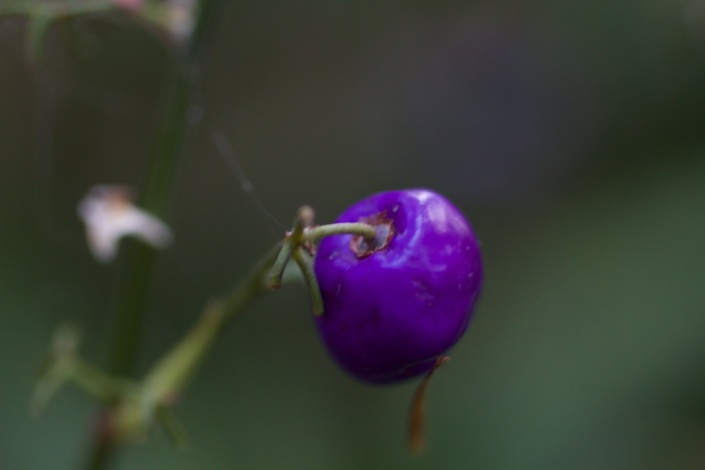
These are a native bush food, with a pleasant, if not overly strong flavour.

I picked a good harvest of them one afternoon, supplemented by takings from our raspberry and blueberry plants.

Together, they made a delicious dessert, when combined with greek yoghurt and our own honey.
A feast for both the eyes and mouth!
Why you shouldn’t plant citrus trees in the verge

Before Lewisham, we lived in a unit in Chippendale. Surrounded by the local guerrilla gardening of the verge, we were equally enthusiastic when we moved into our new house.
We remain strong supporters of the principle of gardening the verge (nature strip). We’ve learned along the way, however, a bit about what works and what doesn’t.
What works in the verge
There are many possibilities for gardening the verge, while staying in local council guidelines.
“Pick and come again” mediterranean herbs work particularly well. They’re tough, attractive, and useful for office workers heading home to make their evening meal. Olive trees and bay trees also work well, acclimatised as they are to tough conditions.
There are plenty of native plants that work well in the verge, from low-running ground-covers and strap-leaf grasses, through to hardy bushes and small trees. (We’re quite pleased with our native verge.)
What doesn’t work in the verge
Our biggest lesson is that citrus trees don’t work well in the verge. Since this is the hardest learned lesson for us, it’s worth sharing a few specific reasons:
- Citrus trees are gross feeders. That is, they require a lot of food, throughout the year. Without this, they remain stunted and fruit-less. (For example, for us to get lots of limes, we greatly ramped up our feeding regimen.)
- Citrus are attacked by bugs and diseases. There’s practically nothing that they aren’t attacked by, including citrus leaf miners, stink bugs, aphids, thrips and citrus gall moth, to name just a few.
- Citrus aren’t set-and-forget. For the reasons listed above, citrus need constant monitoring and care, for their entire lifetime.
- They get stolen. Mirroring the experience in Chippendale, three of our four citrus trees were stolen in the first fortnight, the last being left only because it looked so poor.
- People are impatient. While the whole idea of edible plants in the verge is to share the bounty, we’ve found that the fruits get taken well before they’ve even ripened.
- People are careless. More often than not, a whole branch will be ripped off, rather than a single fruit twisted free.
In short, don’t plant citrus. Beyond this, each local council will have guidelines about what not to plant. Large street trees are typically seen, for example, as the sole domain of the council to plant.
But there are plenty of other options! May your verge live well and prosper.
Fifty plants now in around Lewisham Station

Since my early native plantings around Lewisham Station, I’ve been steadily adding to the collection, mostly by planting a few of my hand-raised cuttings each weekend.
I’ve now reached the milestone of fifty plants. These are planted closely together — typically about 30cms apart — to create a dense “bush pocket” effect.
While that might seem like a crazy amount of over-planting, it’s all to a plan:
- At the back of the strip, a canopy of small trees, including acacias (wattles) and callistomons (bottle brushes).
- A mid story of native bushes, including westringias (native rosemary), correas (native fuchsia) and prostantheras (mint bushes).
- A bottom story of strap-leaf plants at the front of the strip, and a mix of hardy groundcovers throughout the rest.
I reckon there may be 30-50 more plants required to fill it all out, but I’ll continue the slow-and-steady approach.
So far only two plants have died, and they were struggling as cuttings even before I planted them out.
Fingers crossed the rest will keep on going strong!
Digging up the last of our nature strip

Soon after we moved into our house in Lewisham, we dug up a section of the nature strip, and planted citrus trees and herbs. While three of the citrus were immediately stolen, we continued to build up the strip in front of our door, until it was lush and vibrant.
A year ago, we pulled up another section of the nature strip, and native plantings quickly took over.
As it turns out, the local council would actually prefer us to pull up little sections of grass, rather than leave them squeezed in amongst other plantings. This makes life easier for the council staff who do the mowing, and helps to reduce the cost of maintaining the streets.
So with just one piece of grass left between the two sets of plantings, we sorted that out this last weekend.

The process of pulling out the grass is easier than it looks. The roots are shallow, so some mattock work lifts out chunks of grass. It’s then just a matter of digging through the soil to get out as many remnant grass roots as possible.
I then topped it up with some spare soil, and added a little native plant fertiliser.
I’ve been growing a number of native plants from cuttings, so these provided the start of what should become a thick bushy area. Plants include mint bushes (prostanthera), correas, dianellas, and a number of ground covers (including pigface). (We planted the grevillea six months ago.)
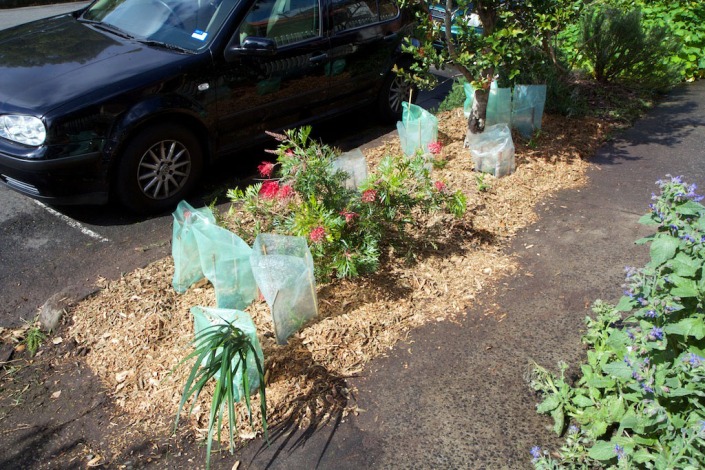
I collected some free mulch from the local council nursery, and the end result looks rather good I think. Over the next month I’ll finish off the plantings, and by then I’m expecting the seedlings to start putting on some serious growth.
Another piece of grass replaced by native plants, yay!
(Not) guerrilla gardening around Lewisham train station

The area around Lewisham train station is a desolate wasteland. Other than a row of large palm trees, there’s a disintegrating raised garden bed, and a long strip of browning weeds. Hardly a joy to behold.
Following a casual suggestion from a neighbour, I guerrilla gardened in a number of gymea lilies, underneath the palm trees. These are extremely tough, and will grow to a size large enough to visually fill in the gaps along the fence.
That got me started, so I continued on to plant a small patch of native plants at the start of the pedestrian walkway that runs alongside the train line.
I’ve since expanded this a little, and it now consists of a mix of acacias (to start enriching the soil), hardy native shrubs (westringias, etc) and strap-leafed plants (lomandras, dianellas).

This has not been without some challenges:
- The railway put in a huge new vandal-proof black fence, and the workers trampled some of the plants in the process (although most survived!).
- The regular railway workers tend to roll their trucks over the garden every once in a while.
- Kids keep stealing the stakes, so the plant guards blow away.
- It’s only rained once in the last 3 months, so hand watering is critical in this early stage.
Despite this, many of the plants, particularly the bushes, are already growing rapidly. I’ve also got a heap of cuttings that should be ready for planting out soon.
Why do this?
A few people have asked me “why bother doing all this, it isn’t your problem?”.
There are a few reasons:
- It’s nice to live in a lovely local environment, and the current station environment is far from lovely.
- It’s also good to increase the local biodiversity, encouraging more birds, insects, etc.
- This land belongs collectively to us, as the local residents. The Council is just the steward of the land, looking after it on our behalf.
- This gives us a responsibility to participate in sustaining and improving the environment.
- Someone should be doing it! The Council, even with the best of wills, can’t do everything for us.
- It’s enjoyable and satisfying to see something grow and prosper.
It’s now official
I also struck up a conversation with the lovely folks at Marrickville Council, who have endorsed the use of the land as a low-maintenance community native garden.
So it’s no longer guerrilla gardening … it’s official gardening. Where’s the fun in that! 😉
Watch this space for updates as the space (hopefully) starts to bush up and spread out…
Reclaim the curb (and win a prize!)
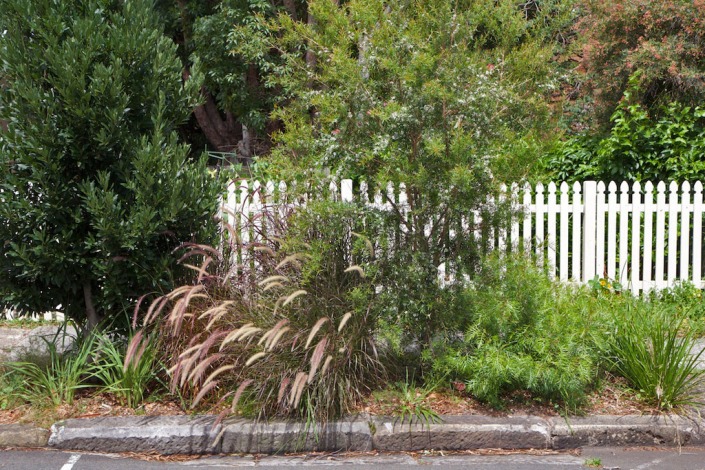
We’re great believers in homeowners playing a direct role in their street. The most visible (and perhaps the easiest!) way is to plant out the verge.
In our case, we’ve planted one verge with native plants (above), as well as a second containing herbs and other edibles. Both are lovely to walk by (we think).
That’s why we’re excited to hear about the Reclaim the Curb initiative, who are holding a competition to Create Australia’s Most Edible Curb.
What a great idea! So get planting, and submit your efforts to win a prize 🙂
(The deadline is 5pm 31st May 2013.)